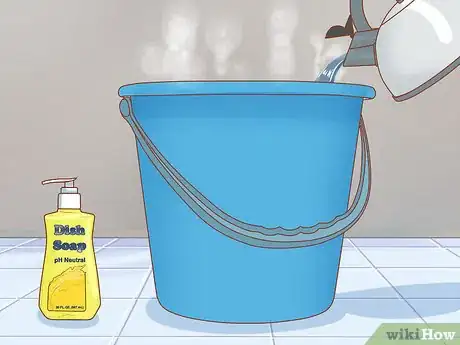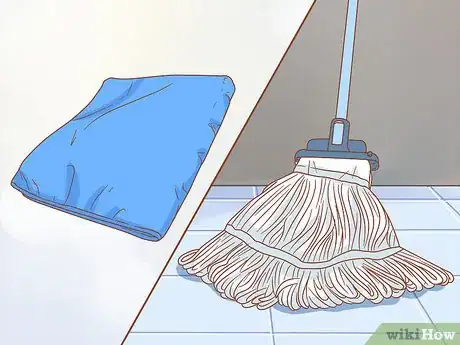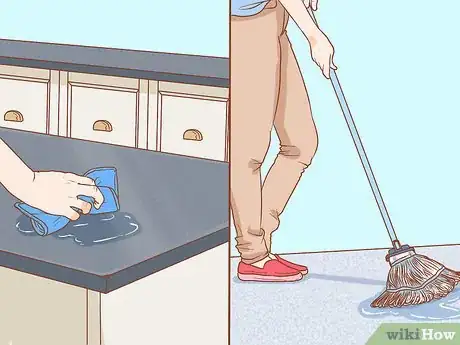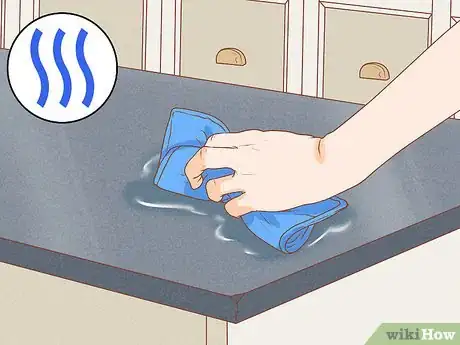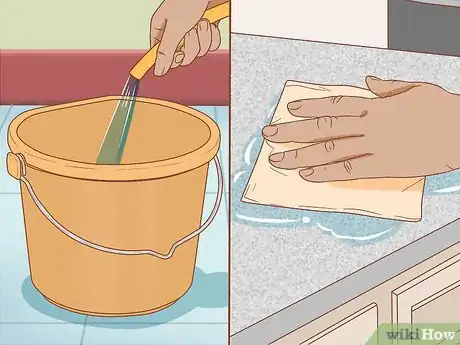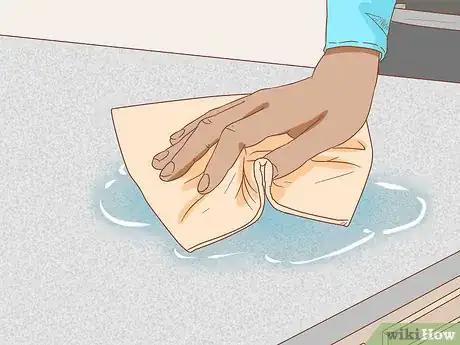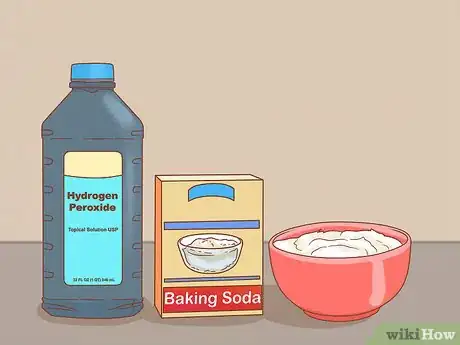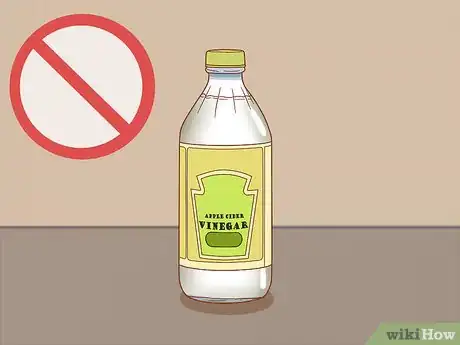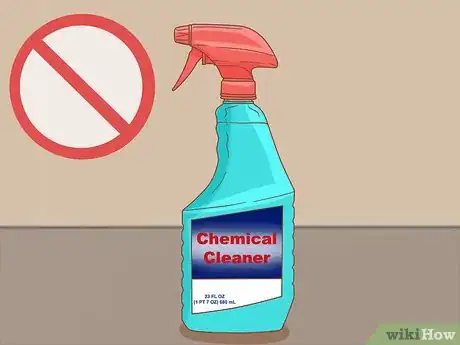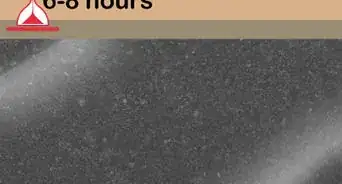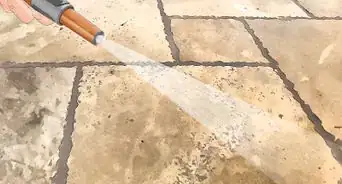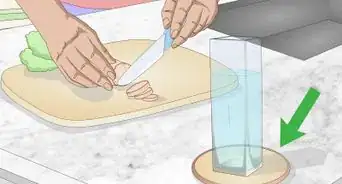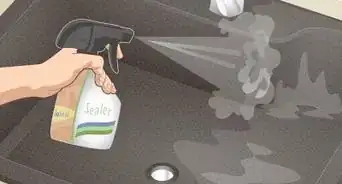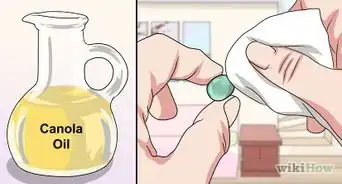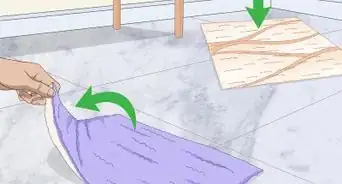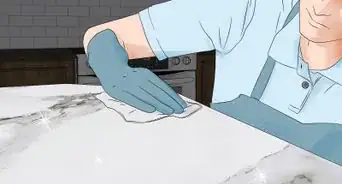This article was co-authored by Michelle Driscoll, MPH and by wikiHow staff writer, Eric McClure. Michelle Driscoll is the Owner of Mulberry Maids, which is based in Fort Collins, Colorado. With five years of experience, her business specializes in cleaning homes and small offices. She holds a Masters in Public Health from the Colorado School of Public Health. Additionally, Mulberry Maids has an A+ rating from the Better Business Bureau.
There are 11 references cited in this article, which can be found at the bottom of the page.
This article has been viewed 10,333 times.
Granite is a popular material for countertops and flooring alike. It has a unique appearance and texture, and it tends to be highly durable.[1] However, it's very important to make sure you're cleaning your granite correctly– you could cause permanent damage if you don't. To keep your granite shiny and clean, perform regular cleanings every week, use deep cleanings if the granite hasn’t been properly cleaned in some time, and avoid common mistakes like using vinegar or acidic cleaners.
Steps
Performing a Regular Cleaning
-
1Check to make sure that your granite is sealed before doing anything else. Most granite is sealed after it is installed, but it needs to be resealed every once in a while. To see if your granite needs to be resealed, pour a small amount of water onto its surface. If the water beads up into small balls, your granite is properly sealed. If it doesn't, your granite is unsealed, and you should avoid cleaning it– the water will seep into the porous rock and potentially damage it.[2]
- Reseal your granite if it needs to be resealed by covering the granite in a specialized granite sealant and wiping away excess sealant after it rests. After multiple sealant applications, your granite will be safe to clean.[3]
- As a general rule, it's a good idea to seal your granite about once per year to make sure that the stone doesn’t get damaged and maintains its color.[4]
-
2Fill your sink or large bucket with warm water and dish soap. Combine a bucketful of warm water with 2 teaspoons of dish soap. Pour your dish soap in while the water is pouring so that it mixes evenly with your water.[5]
- Make sure that your dish soap is pH neutral and doesn’t contain any acidic elements. Read the label to see if there is any extract or citrus in the dish soap. If there is, you can’t use it because the acid will wear away the granite.[6]
Advertisement -
3Use a microfiber cloth for smaller jobs and a mop for bigger areas. A small microfiber cloth works best for small tables or countertops. You may want to use a larger microfiber cloth for bigger surface areas. If you have a large area of granite flooring that you need to clean, consider using a mop.[7]
- Whether you use a mop or a microfiber, make sure that it is clean first.
- An abrasive sponge, like a scotch-brite sponge, will scratch your granite, so it's best to avoid using sponges like these.[8]
-
4Submerge your cloth, rag, or mop in your cleaning solution and wring it out. Let your cloth or rag rest in the solution for a moment so that it soaks thoroughly. Once it’s soaked, lift it out of the solution and wring it into your bucket or sink to remove the excess water and soap.[9]
- You want your cloth, rag, or mop to be damp, but not soaked. If it’s dripping with water, wring it out further by twisting it in your hand.[10]
-
5Wipe the granite in soft circular motions so that you don’t damage the stone. You don’t need to scrub aggressively to clean your granite– cleaning too vigorously can actually damage the stone by removing the sealant. Simply run your cloth, rag, or mop freely across the surface in a circular motion until you’ve covered the entire area.[11]
- If you want to add shine, apply a little cooking oil to your rag. Then, slowly buff the granite using slow, circular motions. The oil will also protect from stains.[12]
-
6Dry your granite with a soft microfiber cloth. You don’t want to leave your granite wet or damp, as this will leave water stains behind. Wipe the surface softly to soak up any excess cleaning solution. Your granite should be dry to the touch when you’re done.[13]
Deep-Cleaning Granite Surfaces
-
1Fill your bucket or sink with a specialized cleaner. There are several companies that produce specialized cleaning solutions for granite. You can purchase most of them at your local hardware store, found alongside other cleaning supplies. These solutions will remove residue that some dish soaps may leave behind.[14]
- You can also use warm water and 2 teaspoons of dishwashing soap if you don’t have any granite-specific cleaner around, but a special granite cleaner is designed to keep granite healthy during a deep clean.
-
2Soak a clean mop or small cloth in the cleaner and wring it out. You should make sure that your mop or cloth is submerged in the liquid, and then wring it out so that it’s damp. You don’t need your cloth or mop to be soaking wet to perform a good deep cleaning.[15]
- If your mop or cloth is dripping with cleaner, wring it out further.
-
3Use short and gentle strokes to cover the entire surface. Generously cover the surface that you’re cleaning with your mop or cloth. Avoid scrubbing too hard, because you could remove the sealant. Simply hold your mop or cloth firmly and run it across the entirety of your granite surface.[16]
- Each stroke should overlap in a circular motion so that each portion of the granite gets at least two applications of cleaning solution.
-
4Refill your bucket with cold water and clean the surface again. This time, don’t add any soap or specialized granite cleaner, and make sure that the water is cold. Repeat the cleaning process by submerging your cloth or mop and wringing it out. Make sure to cover every section that you used the cleaner on originally.[17]
-
5Take a clean microfiber cloth and buff the granite clean. Using a dry microfiber cloth, soak up the excess water by rubbing it dry. You don’t want to let your granite remain wet for too long, or you could end up with unwanted water stains.[18]
-
6Spray down your granite with a mixture of isopropyl alcohol and water. After your granite surface has been cleaned, fill an empty spray bottle halfway with isopropyl alcohol and fill the other half with water. Shake it a little bit in your hand to make sure that the alcohol and water mix evenly.[19] Cover the entire surface with your spray and let it rest for 3-5 minutes. Dry it with a microfiber cloth or soft rag.
- This will make your granite shine like new, and has the added benefit of disinfecting it.[20]
Removing Stains from Granite
-
1Mix baking soda and hydrogen peroxide in a small bowl. Start with a tablespoon of hydrogen peroxide and add it to your baking soda. Continue to add hydrogen peroxide as you mix it until you’ve got a thick paste. Your mixture should be malleable, but firm.[21]
- Mix the baking soda with water instead of hydrogen peroxide for oil-based stains.
-
2Spread your paste over the stain and cover it with plastic wrap. Evenly spread the paste across your stain with a spoon. Take a sheet of plastic wrap and cover the paste. Apply light pressure to the plastic wrap so that it’s lightly pressing down on the paste. Tape your plastic wrap to your table, countertop, or floor.[22]
- Any kind of tape can work, but painter’s tape is the least likely to leave a residue on your granite when you take it off.
-
3Leave your paste on the granite overnight before wiping it down. You can also leave the paste on the stain for several days if you’d like. It won’t damage the granite, and may ensure that you’ve fully removed the stain. After the paste has settled for several days, lift up the plastic wrap before rinsing and wiping down the granite with cold water and a microfiber cloth.[23]
Avoiding Common Mistakes
-
1Use as little water as possible so you don't discolor the granite. Excess or pooling water can discolor your granite, so don't use too much water while you're cleaning. Additionally, make sure you completely dry the granite after you clean it. This will prevent streaks and discoloration.[24]
-
2Skip using vinegar to clean your granite, or you may risk damaging it. Some people use vinegar as a cleaning solution in their home. It is inexpensive and tends to be effective against mold. However, vinegar is acidic and will erode the sealant on your granite.[25]
- Vinegar, even in small amounts, will also remove the shine from your granite.[26]
-
3Avoid using any harsh abrasives or chemical cleaners. Any chemical cleaner or harsh abrasive is going to wear away the sealant and damage your stone. These cleaners are typically designed to penetrate surfaces, which is what you don’t want to do when cleaning granite.[27]
- Both steel wool and scrubbing sponges are both harsh abrasives, so don't use them.
- This also includes 409, bleach, Windex, which are highly acidic and will wear away the sealant.[28]
-
4Use cutting boards and coasters to prevent direct damage to your granite. If your granite is in your kitchen, make sure that you always use a cutting board when preparing meals. If you have a drink in the kitchen, use a coaster. Many people believe that granite can safely handle a knife or simple cup, but a cutting board or coaster can prevent permanent stains, rings, or damage to your granite.[29]
Things You’ll Need
Performing a Regular Cleaning
- Sealant (if needed)
- Large bucket
- Microfiber cloth or mop
- Dish soap
Performing a Deeper Cleaning
- Specialized granite cleaner
- Microfiber cloth or mop
- Isopropyl alcohol
- Spray bottle
Removing Stains from Granite
- Baking soda
- Hydrogen peroxide or water
- Plastic wrap
- Tape
- Microfiber cloth
References
- ↑ https://www.washingtonpost.com/lifestyle/style/granite-why-every-homeowner-wants-a-piece-of-the-rock/2012/02/01/gIQANBN4uQ_story.html?utm_term=.1985b2cdc3f5
- ↑ https://www.digitaltrends.com/home/how-to-clean-granite-countertops/
- ↑ https://youtu.be/ffUcD0erfLs?t=68
- ↑ https://www.firstforwomen.com/posts/how-to-clean-granite-countertops-164786
- ↑ https://www.cleanipedia.com/in/en/floor-and-surface-cleaning/how-to-clean-marble-granite.html
- ↑ https://www.digitaltrends.com/home/how-to-clean-granite-countertops/
- ↑ https://www.cleanipedia.com/in/en/floor-and-surface-cleaning/how-to-clean-marble-granite.html
- ↑ https://www.bobvila.com/articles/how-to-clean-granite-countertops/
- ↑ https://www.firstforwomen.com/posts/how-to-clean-granite-countertops-164786
- ↑ https://www.firstforwomen.com/posts/how-to-clean-granite-countertops-164786
- ↑ https://www.firstforwomen.com/posts/how-to-clean-granite-countertops-164786
- ↑ https://www.diynetwork.com/how-to/maintenance-and-repair/cleaning/how-to-clean-granite-countertops
- ↑ https://www.digitaltrends.com/home/how-to-clean-granite-countertops/
- ↑ https://www.architypes.net/countertops/granite/cleaning/
- ↑ https://www.cleanipedia.com/in/en/floor-and-surface-cleaning/how-to-clean-marble-granite.html
- ↑ https://www.cleanipedia.com/in/en/floor-and-surface-cleaning/how-to-clean-marble-granite.html
- ↑ https://www.cleanipedia.com/in/en/floor-and-surface-cleaning/how-to-clean-marble-granite.html
- ↑ https://www.cleanipedia.com/in/en/floor-and-surface-cleaning/how-to-clean-marble-granite.html
- ↑ https://youtu.be/eWxumwp1hOk?t=90
- ↑ https://youtu.be/eWxumwp1hOk?t=90
- ↑ https://www.bobvila.com/articles/how-to-clean-granite-countertops/
- ↑ https://www.bobvila.com/articles/how-to-clean-granite-countertops/
- ↑ https://www.bobvila.com/articles/how-to-clean-granite-countertops/
- ↑ https://www.bobvila.com/articles/how-to-clean-granite-countertops/
- ↑ https://www.granitegold.com/why-not-clean-granite-with-vinegar/
- ↑ https://www.granitegold.com/why-not-clean-granite-with-vinegar/
- ↑ https://youtu.be/eWxumwp1hOk?t=20
- ↑ https://www.diynetwork.com/how-to/maintenance-and-repair/cleaning/how-to-clean-granite-countertops
- ↑ https://www.digitaltrends.com/home/how-to-clean-granite-countertops/

